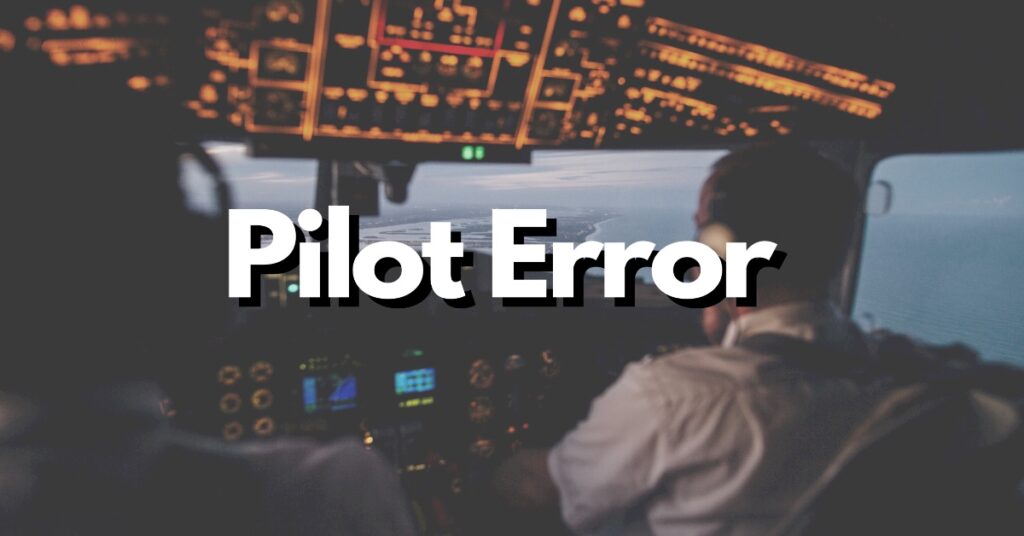In the complex world of aviation, the responsibility of a pilot extends far beyond the confines of the cockpit. Pilots are entrusted with the safety of passengers, crew, and aircraft, making adherence to rules, regulations, and best practices paramount. However, the term “pilot error” casts a shadow over this noble profession, representing a range of human mistakes that can have catastrophic consequences.
In this article, we delve into the depths of pilot error, exploring its various forms, common occurrences, and strategies to prevent its recurrence.
The Anatomy of Pilot Error
Pilot error, in its various manifestations, encapsulates any misstep or lapse in judgment made by a pilot before or during a flight. The breadth of this concept places a profound duty of care on aviators to navigate within the confines of aviation laws and industry standards.
Whether it’s a minor oversight or a major breach, pilot error can potentially set the stage for a grave disaster. Most notably, pilot error stands as the predominant category of human error in aviation accidents.
Common Manifestations of Pilot Error
A litany of scenarios fall under the umbrella of pilot error, revealing the multifaceted nature of this challenge. These common instances include:
- Inadequate Preflight Procedures: Neglecting preflight checklists and essential tasks, such as ensuring a secured cockpit door, can compromise the safety of the flight.
- Inexperienced Piloting: Operating an aircraft without requisite experience, training, or licensure can lead to critical errors that jeopardize the well-being of all onboard.
- Weather Neglect: Failing to assess weather conditions prior to flight can expose an aircraft to unforeseen hazards and turbulence.
- Checklist Negligence: Skipping pre-flight checklists can result in overlooked critical steps that contribute to avoidable mishaps.
- Lack of Communication: Failing to communicate effectively with air traffic controllers or disregarding their directives can lead to misjudgments and collisions.
- Improper Takeoff or Landing Procedures: Utilizing incorrect takeoff or landing techniques can compromise the aircraft’s stability during crucial phases of flight.
- In-Flight Decision-Making: Poor decisions made during flight, influenced by factors such as weather or external pressures, can lead to dire consequences.
- Navigation Errors: Miscalculations in navigation can lead to unintended deviations from flight paths, increasing the risk of collisions or getting lost.
- Equipment Misuse: Incorrect usage of flight equipment or technology can compromise the aircraft’s systems and operational safety.
- Altitude Mismanagement: Flying at an improper altitude, whether too low or in restricted airspace, heightens the risk of accidents.
- Fuel Mismanagement: Failing to account for sufficient fuel reserves can result in emergency situations and forced landings.
- Impaired Operation: Piloting an aircraft while under the influence of alcohol, drugs, or fatigue severely impairs judgment and reaction times.
The Alarming Statistics
Perhaps the most disconcerting statistic is that over 75% of general aviation accidents occur due to pilot error. The recurrence of specific types of pilot errors highlights the urgency of addressing these issues head-on. The implications of these errors underscore the importance of continuous training, meticulous procedures, and unwavering vigilance.
Preventing Pilot Error
The aviation community acknowledges the criticality of addressing pilot error and continually strives to enhance safety measures. Prevention strategies encompass a spectrum of actions, including:
- Robust Training: Ensuring pilots receive comprehensive and ongoing training tailored to their level of experience.
- Preflight Diligence: Adhering to preflight checklists and procedures rigorously to eliminate oversights.
- Effective Communication: Encouraging open and clear communication between pilots and air traffic controllers to mitigate misunderstandings.
- Adequate Rest: Promoting proper rest and combatting fatigue to maintain optimal cognitive function.
- Stress Management: Equipping pilots with tools to manage stress and make sound decisions even in challenging situations.
Conclusion
The specter of pilot error looms as a significant challenge in aviation safety. By acknowledging its existence, understanding its manifestations, and implementing robust preventive measures, the aviation community can strive to reduce the incidence of pilot error.
The pursuit of safer skies remains a collective responsibility that pilots, regulators, and stakeholders alike must wholeheartedly embrace.
